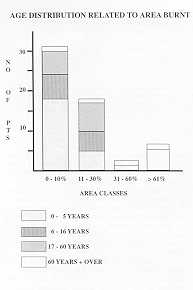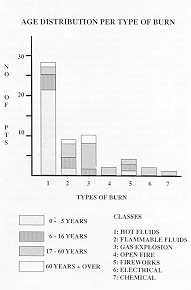Annals qf the MBC - vol, 3 - n' 1 -
March 1990
FACILITIES FOR
TREATING BURNS IN MALTA
Swain C.
Burns Unit, St Luke's Hospital, G'Mangia, Malta
SUMMARY. An account is given of
the state of bums therapy on the island of Malta, which has a population of one third of a
million, increasing in the holiday season. With such a small population, the number of
burn patients is not high, and the Author expresses his pleasure at the creation of the
MBC, a development that not only gives Maltese medical and paramedical stalYthe chance to
work in other Mediterranean countries, thus increasing their expertise, but also provides
the opportunity for the Maltese Burns Unit to accept a small number of patients from
overseas, should the need arise.
Malta has a population of one third of a
million although this number is somewhat increased during the tourist season mainly by an
influx of people from the United Kingdom and other Northern European countries. The
medical facilities on the island are centred around St. Luke's Teaching Hospital which is
a large complex of over one thousand beds.
For the past twelve years our policy has been to admit all children with bums over 5% of
the body surface and all adults with burns over 10%. Patients with smaller burns are also
admitted, especially if elderly (1) or if they have suffered deep burns which require
early excision and skin grafting. During this period 40 to 60 patients have required
admission annually although the incidence of burns in the latter years has shown a
downward trend. When the Burns Unit was planned, it was therefore considered that 6 beds
would be more than adequate for the needs of the population under normal circumstances.
The unit is staffed by 6 nurses who work in shifts and one resident surgeon who rotates to
the Bums Unit for a 6-month period as part of his general surgical training. One
consultant surgeon whose main workload in the hospital is Plastic Surgery and one general
surgeon who is interested in the treatment of bums make up the rest of the team. Back-up
facilities by ancillary services, including physiotherapy, anaesthesia and laboratory
facilities, are excellent. Patients with inhalation injury are initially treated in a
general intensive care unit where an isolated cubicle is available with the possibility of
full respiratory support.
The Burns Unit has facilities to control ambient temperature and humidity and most
patients are treated by the exposure method. Mediscus air-beds and an Argo bath are
available and hydrotherapy is widely practised. Facilities for burns debridement, skin
grafting and minor surgery are available in the unit itself. It is also possible to carry
out peritoneal lavage or haemodialysis on the unit.
Patients with small bums who do not require hospital admission are seen regularly in an
annex to the Burns Unit. Patients who have previously required treatment in the unit are
also followed-up here. Fitting of pressure garments, planning of physiotherapy, further
surgery and rehabilitation can therefore be undertaken by the staff who treated them in
the acute phase.
56 patients with burns were admitted to St. Luke's Hospital over the past year and Fig. 1
summarizes their age and the type of bum. Scalds occurred in 29 patients, mainly children
under 5 years. Accidents with flammable fluid caused burns in 9 patients and domestic gas
explosions accounted for 10 patients, most of whom were young adults. There were 2
patients who were burned by an open fire, 4 who were involved in a fireworks explosion, 2
patients with electric burns and one patient with a chemical burn.
Fig. 2 relates the percentage area of the
burn in these patients to their age. 31 patients had a bum involving up to 10% of the body
surface. 19 patients had a bum of 11 to 30% and 2 patients had a bum of 31 to 60%. The 6
patients with a burn over 60% include one patient with an 80% burn and 3 patients with
bums over 90%. Gas explosion and flammable fluid were the cause of these major burns.
21 patients underwent anaesthesia during their course of treatment. These include 2
patients with inhalation injury who required early tracheostomy and 9 patients who
required skin grafting on one or more occasions.
Renal failure was the major cause of death in 3 patients, septicaemia in 3 patients,
multiple injury in one and congestive heart failure in another. Infection of the burn
wound was significant in 16 or the 48 patients who survived. Bacteriological culture of
the burn wound in these patients showed that Pseudomonas and Proteus accounted for the
more serious infections.
The average hospital stay of the patients with a bum of 10% or less was 15 days, while for
patients with a bum of I I to 30% it was 20 days. Of the two patients in the 31 to 60%
group, one was sent home after 45 days and the other died after 6 days. 7 of the 8
patients with a bum of 61% or more died, their mean survival being I I da)~s.
The pattern of bums trauma in Malta and the results of treatment are broadly similar to
that seen in other Mediterranean countries (2) although sunburn is not as common as it
seems to be in Greece (3). Childhood scalds are common and sometimes aggravated by
chemical injury. It is still customary to boil clothes in a detergent solution on an open
fire in a backyard. Scalds caused in this way are often extensive and deep. More than half
of our households use bottled gas for cooking purposes and explosions involving gas
cylinders account for a high proportion of our bums fatalities. The manufacture of
fireworks for use in village festas is widespread on the island and explosions involving
the small factories where they are made have resulted in serious burns and multiple
injuries, usually in young men.
We have no experience of bums caused by warfare although fire aboard a hijacked Egypt Air
plane caused a large number of casualties in 1985, mainly through sutTocation as the
passengers were engulfed by smoke in their burning cabin.
Although small in size the Burns Unit in Malta is adequate to cater for the needs of the
population under normal circumstances; seldom do we have to treat more than three or four
patients at any one time. This in itself can be counted as a blessing but at the same time
it puts our stalT at a disadvantage as they can never hope to reach the level of expertise
necessary to treat a large number of serious burns as may occur in a major disaster. The
possiblity of research into the finer details of burns management and the introduction of
new techniques such as skin culture are also limited by the small number of our patients.
This is why 1 am particularly grateful to the Mediterranean Bums Club for the possibility
of sharing the experience of colleagues from larger centres at meetings such as this, and
also for making it possible for the nursing staff in our unit to train in Burns Units
belonging to the Club.
On the other hand Malta does have something to ofTer. The treatment of burns is undertaken
in a large teaching hospital with staff who are well trained in all aspects of medicine
and surgery and this environment is particularly useful to young doctors and nurses from
your Bums Units who would like to widen their training in general and plastic surgery. As
our workload in bums is not too heavy it is also possible to accept a small number of
patients from overseas if the need arises.
RÉSUMÉ. L'Auteur décrit l'état actuel de
la thérapie des brûlures dans l'île de Malte (population environ 330.000, augmentée en
été). Avec une population tellement basse le numéro des brûlés évidemment n'est pas
haut, et l'Auteur exprime son plaisir pour la création de I'MBC parce que non seulement
le Club permet au personnel maltais médical et paramédical de travailler dans les autres
pays méditerranéens et d'améliorer leur préparation scientifique mais en plus il offre
l'occasion à l'Unité des Brûlés de Malte d'acceuillir, en cas de nécessité, un petit
nombre de patients d'outremer.
BIBLIOGRAPHY
- Herd B.M., Herd AX, Tanner N.S.B.: Burns to the
elderly: a reappraisal. Brit. J. Plas. Surg., 40: 278-292, 1987.
- Haberal M. et al.: Analysis of 745 Hospitalised Bum
Patients. Annals of the MBC, 1: 45-47, 1987.
- loannovich 1. et al.: Epidemiological Data on Bum
injuries in Greece. Annals of the MBC, 1: 23-26, 1988.
|

